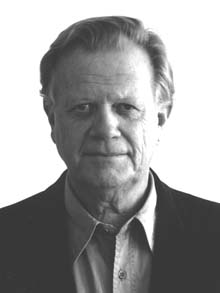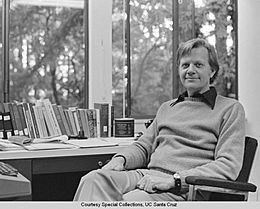Hayden White facts for kids
Quick facts for kids
Hayden White
|
|
|---|---|
 |
|
| Born |
Hayden V. White
July 12, 1928 |
| Died | March 5, 2018 (aged 89) |
| Academic background | |
| Alma mater | University of Michigan |
| Influences |
|
| Academic work | |
| Discipline | History |
| Doctoral students | Nancy Struever |
| Notable students | Lawrence Grossberg |
| Main interests | Metahistory |
| Notable works | Metahistory (1973) |
| Notable ideas |
|
| Influenced |
|
Hayden V. White (July 12, 1928 – March 5, 2018) was an American historian in the tradition of literary criticism, perhaps most famous for his work Metahistory: The Historical Imagination in Nineteenth-Century Europe (1973/2014).
Career
White received his Bachelor of Arts degree from Wayne State University (1951) and his Master of Arts (1952) and Doctor of Philosophy (1955) degrees from the University of Michigan. While an undergraduate at Wayne State, White studied history under William J. Bossenbrook alongside then-classmate Arthur Danto.
In 1998, White directed a seminar ("The Theory of the Text") at the School of Criticism and Theory.
He was elected to the American Academy of Arts and Sciences in 1991. In 2000, he was elected to the American Philosophical Society.
Among White's influences, there were two major figures who taught him "how the historian interprets something." The first was William J. Bossenbrook, who taught White as an undergraduate at Wayne State University. Bossenbrook saw history as fundamentally a story of the conflict between ideas, values, and dreams. Therefore, Bossenbrook regarded history as a mystery to be constantly pondered and studied rather than a puzzle to be solved. In his last book, The Practical Past (2014), White paid tribute to the significant effect of Bossenbrook. The second was 12th-century Jewish philosopher Moses Maimonides, particularly his interpretation of the Bible. Maimonides said that since the creation is vast and complex, and God's will is beyond human's understanding, the goal of biblical interpretation should be to maximize possible interpretations. With this influence, White enjoyed comparing historians' tasks. The influence of Maimonides helped White focus on a variety of possible interpretations of history, not limited or prescribed history, which diminishes the possibility of interpretation.
Metahistory (1973)
In his seminal 1973 book Metahistory: The Historical Imagination in Nineteenth-Century Europe, White claimed that the manifest historical text is marked by strategies of explanation, which include explanation by argument, explanation by emplotment, and explanation by ideological implication. He argued that historical writing was influenced by literary writing in many ways, sharing the strong reliance on narrative for meaning. Therefore, White contradicts the view that "historiography can be objective or truly scientific in itself, unaffected by anything."
White mentions two figures who have enabled people to ask questions about history's objectivity: Marx and Nietzsche. According to White, these thinkers both use their philosophy to consider history which “not only makes us know something about the historical process but know how it knows it." They focus on the problem of history. Marx regards the problem of history as the problem of the mode of explanation, while, for Nietzsche, the problem is the problem of the mode of emplotment. Thus, history is recorded differently depending on which mode the historian chooses. As a result, ‘a value-free history’ cannot be existed. By showing Marx’s and Nietzsche’s argument, White once again emphasizes the importance of the philosophies of history, and history as a well-made or well-constructed narrative.
He insists, in particular in chapter 7, that philosophies of history are indispensable elements in historiography, which cannot be separated from historiography. For him, history is not simply a list of chronological events. White also argued, however, that history is most successful when it uses this "narrativity", since it is what allows history to be meaningful. Emphasizing history as a narrative using language, he argues that true history should contain both characteristics of synchronic and diachronic. This view is contrary to historians such as Eduard Fueter George Peabody Gooch, and Bendetto Croce, who tried to distinguish between historiography and philosophies of history. He ended his career as University Professor Emeritus at the history of consciousness department of the University of California, Santa Cruz, having previously retired from the comparative literature department of Stanford University.
Lawsuit against the LAPD
White figured prominently in a landmark California Supreme Court case regarding covert intelligence gathering on college campuses by police officers in the Los Angeles Police Department. White v. Davis, 13 Cal.3d 757, 533 P.2d 222, 120 Cal. Rptr. 94 (1975). During 1972, while a professor of history at UCLA and acting as sole plaintiff, White sued Chief of Police Edward M. Davis, alleging the illegal expenditure of public funds in connection with covert intelligence gathering by police at UCLA. The covert activities included police officers registering as students, taking notes of discussions occurring in classes, and making police reports on these discussions. White v. Davis, at 762. The California Supreme Court found for White in a unanimous decision. This case set the standard that determines the limits of legal police surveillance of political activity in California; police cannot engage in such surveillance in the absence of reasonable suspicion of a crime ("Lockyer Manual").
Works
While Hayden White is especially known for his analysis of 19th century historiography, his work concerning historical narratives in a more general sense are equally important. The Content of the Form is a collection of essays by White. It shifts his focus in the direction of identifying the importance of narratives in history.
See also
 In Spanish: Hayden White para niños
In Spanish: Hayden White para niños


